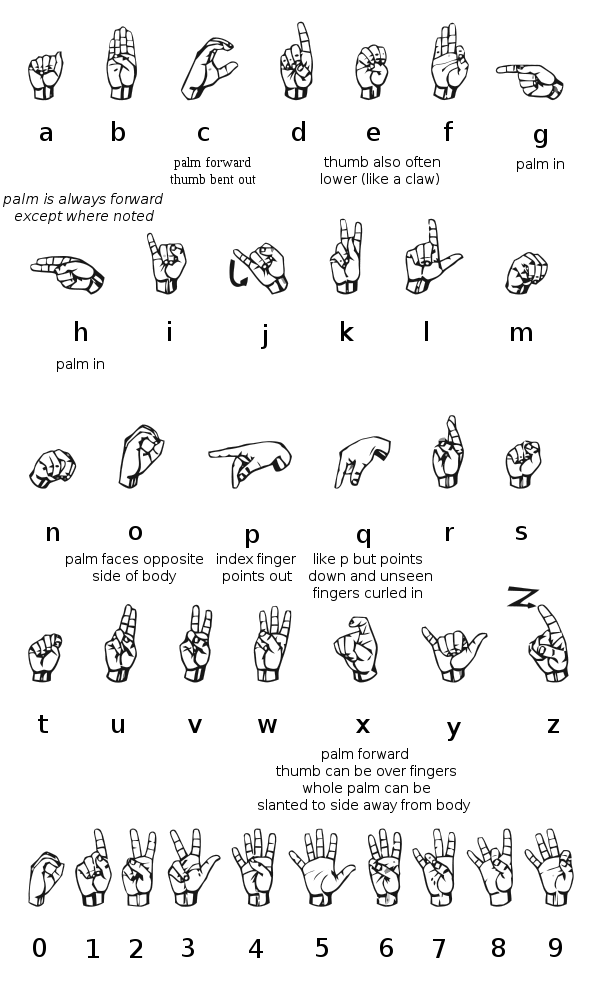- American manual alphabet
-
The American Manual Alphabet is a manual alphabet that augments the vocabulary of American Sign Language when spelling individual letters of a word is the preferred or only option, such as with proper names or the titles of works. Letters should be signed with the dominant hand and in most cases, with palm facing the viewer.
Contents
Chart
The ASL alphabet is based on French sign language and was standardized by Thomas Gallaudet and Laurent Clerc.
Common mistakes
Many mistakes made by beginning fingerspellers are directly attributable to how the manual alphabet is most often shown in graphics.[citation needed]
Letters
In most drawings or illustrations of the American Manual Alphabet, some of the letters are depicted from the side to better illustrate the desired handshape; however in practice, the hand should not be turned to the side when producing the letter. The letters C and O are two that are often mistakenly turned to the side by beginners who become used to seeing them from the side in illustrations. Important exceptions to the rule that the palm should always be facing the viewer are the letters G and H. These two letters should be made, not with the palm facing the viewer or the speaker, but with the palm facing sideways - the hand in an ergonomically neutral position.
Regardless of how they first learn the alphabet, many new signers also commonly confuse "a" and "s." The thumb should be on the side of your fist for the letter "a," but should be folded around the front of your fist for "s."
Also, note that the letter "k" points up, but the letter "p" points down; the handshapes are otherwise the same. In both cases, be sure to put the thumb on your middle finger, not in between your fingers.
The letters "u" and "h" share the same handshape, but "h" points your fingers to the side and "u" points your fingers up.
Another common error is to confuse "d" and "f." With the letter "d," your pointer finger sticks up but your other three fingers are curved inward to touch tips with your thumb. The letter "f" is opposite" you curve your pointer finger inward to touch tips with your thumb but stick the other three fingers upward, in a splayed position. Beginners may wish to be especially careful in double checking that they remember these letters correctly when they work on memorizing the alphabet.
Rhythm, speed & movement
When fingerspelling, your hand should be at shoulder height, and should not 'bounce' with each letter. Your hand should stay in one place and only the handshape changes (and orientation for some letters). If you have trouble doing this, you might want to hold your forearm with your nondominant hand in order to force your spelling hand to stay still. 'Bouncing' the letters makes your fingerspelling difficult to read, even for native signers.
As well, clear handshapes are much easier to read than fast fingerspelling. Do not concentrate on speed, as fast fingerspelling with poorly formed handshapes will be difficult to read. Try to fingerspell the whole word at the same speed, not speeding up or slowing down. A pause indicates the beginning of a new word, so if you suddenly slow down because a letter combination is difficult, your reader may think you are starting a new word, leading to misunderstanding. An exception to this sometimes appears at the beginning of a word. The first letter may be held for the length of a letter extra as a cue that the signer is about to start fingerspelling.
External links
- ASL Fingerspelling Resource Site Free online fingerspelling lessons, quizzes, and activities.
- ASL Fingerspelling Online Advanced Practice Tool Test and improve your receptive fingerspelling skills using this free online resource.
- Fingerspelling Beginner's Learning Tool Learn the basic handshapes of the fingerspelled alphabet.
- Manual Alphabet and Fingerspelling Further information, fingerspelling Tips and video example of ASL Alphabet.
Categories:
Wikimedia Foundation. 2010.

